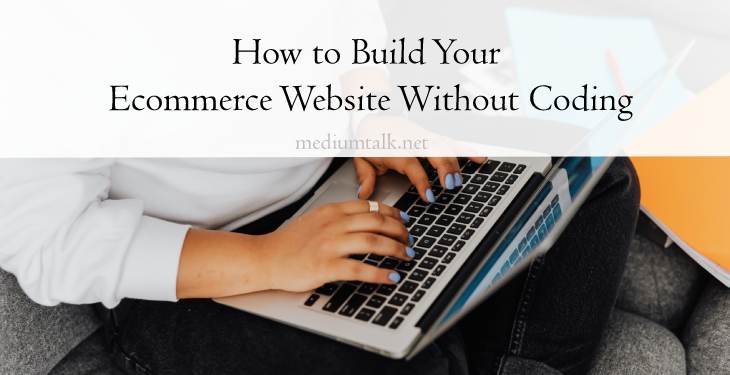Building an ecommerce website can be a daunting task, especially if you don’t have any coding experience. However, with the right tools and strategies, it’s possible to build a successful ecommerce website without writing a single line of code. In this article, we’ll take a look at some tips and tools to help you build ecommerce website without coding.

1. Choose a Website Builder
The first step in building an ecommerce website without coding is to choose a website builder. A website builder is an online tool that allows you to create a website without any coding knowledge. There are many website builders available, each with its pros and cons. Some popular website builders include Wix, Squarespace, Shopify, and BigCommerce.
When choosing a website builder, consider factors such as ease of use, pricing, and features. Look for a website builder that offers ecommerce functionality, such as product pages, shopping carts, and payment gateways.
2. Choose a Template
Once you’ve chosen a website builder, the next step is to choose a template. A template is a pre-designed layout that you can customize to suit your brand and business. Most website builders offer a range of templates to choose from, each with different styles and layouts.
When choosing a template, consider factors such as your brand identity, target audience, and the type of products you sell. Look for a template that is easy to navigate and visually appealing, with clear calls to action.
3. Customize Your Template
Once you’ve chosen a template, it’s time to customize it to suit your brand and business. Most website builders offer drag-and-drop editors that allow you to easily customize your template without any coding knowledge.
Customization options may include changing colors, fonts, and images, as well as adding and removing sections and pages. Keep in mind that while customization is important, it’s also important to keep your website clean and easy to navigate. Avoid clutter and unnecessary elements that may distract from your products and calls to action.
4. Add Product Pages
Product pages are the heart of your ecommerce website. They should be informative, visually appealing, and easy to navigate. Most website builders offer product page templates that you can customize to suit your products and brand.
When creating product pages, include clear product descriptions, high-quality images, and pricing information. You may also want to include customer reviews and ratings to help build trust and credibility.

5. Set Up Payment Gateways
Setting up payment gateways is essential for any ecommerce website. Payment gateways allow you to securely process transactions and accept payments from customers. Most website builders offer a range of payment gateway integrations, such as PayPal, Stripe, and Square.
When choosing a payment gateway, consider factors such as fees, security, and ease of use. Make sure to test your payment gateway to ensure that transactions are processed smoothly and securely.
6. Set Up Shipping Options
Setting up shipping options is another important aspect of building an ecommerce website. You’ll need to choose a shipping provider and set up shipping rates for your products. Most website builders offer integrations with popular shipping providers, such as UPS, FedEx, and USPS.
When setting up shipping rates, consider factors such as weight, dimensions, and destination. You may also want to offer free shipping promotions to incentivize customers to make a purchase.
7. Optimize for SEO
Search engine optimization (SEO) is essential for any ecommerce website. SEO involves optimizing your website to rank higher in search engine results pages (SERPs). This can help drive organic traffic to your website and increase sales.
Some tips for optimizing your ecommerce website for SEO include using descriptive product titles and descriptions, using relevant keywords, and optimizing your website for mobile devices. You may also want to consider creating a blog to attract more traffic and improve your website’s local SEO.
8. Test and Launch Your Website
Before launching your ecommerce website, it’s important to thoroughly test it to ensure that everything is working properly. Test your website’s functionality, such as shopping carts, payment gateways, and shipping options, to make sure that everything is working smoothly.
Once you’ve tested your website and made any necessary changes, it’s time to launch it. Be sure to promote your website on social media and other channels to drive organic traffic and attract customers. Consider offering promotions or discounts to incentivize customers to make a purchase.

9. Monitor and Improve Your Website
Building an ecommerce website is an ongoing process. Once your website is up and running, it’s important to monitor its performance and make improvements as needed. Use analytics tools to track website traffic, sales, and customer behavior.
Based on your analytics data, make changes to your website to improve its performance. This may include optimizing product pages, changing pricing, or offering new promotions. Regularly testing and making improvements to your website will help you stay ahead of the competition and grow your business over time.
10. Focus on User Experience
When designing your ecommerce website, it’s important to keep the user experience (UX) in mind. Your website should be easy to navigate, with clear categories, search functionality, and intuitive navigation. Your product pages should include high-quality images and detailed descriptions to help customers make informed purchasing decisions.
Consider adding customer reviews and ratings to your product pages, as this can help build trust and credibility with potential customers. You should also make sure that your website is optimized for mobile devices, as more and more people are shopping online using their smartphones.
For an optimal mobile experience, you can also consider creating an app for your customers. DIY no-code tools like AppMySite’s ecommerce mobile app builder make it easy for online store owners to develop apps without coding.
In conclusion, building an ecommerce website without coding is possible with the right tools and strategies. By choosing a website builder, customizing your template, adding product pages, setting up payment gateways and shipping options, optimizing for SEO, testing and launching your website, and monitoring and improving your website, you can build a successful ecommerce website that attracts customers and drives sales. Keep in mind that building an ecommerce website is an ongoing process, so be prepared to make changes and improvements over time to stay ahead of the competition and grow your business.
